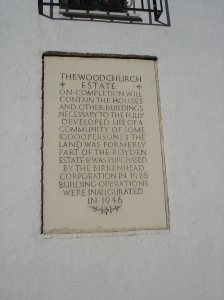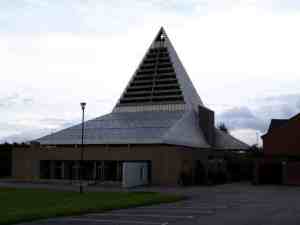The boom and bust of Council housing and the Modernist ideal
By Kenn Taylor
“Ideology collapses and vanishes, utopianism atrophies, but something great is left behind: the memory of a hope”. Henri Lefebvre.
As a child, on every walk to and from my Primary School, I would pass a large plaque that fascinated me:
The Woodchurch Estate
On completion will contain the houses and other buildings necessary to the fully developed life of a community of some 10,000 persons. The land was formerly part of the Royden Estate and was purchased by the Birkenhead Corporation in 1926. Building operations were inaugurated in 1946.
That plaque, on the first house built on the estate, I have no doubt helped spark what would become my fascination for history, a desire to know just why things were the way they were. Its hope, for a new community started a year after the end of World War II, also resonated with me.
Older, and my curiosity having pushed me towards an understanding of Modernism and social housing, I came to realise how standing on the edge of the valley where I grew up, between Arrowe Park and Bidston Hill in Birkenhead, it was possible to look upon the rise and fall of Modernist social housing.
The Woodchurch estate began construction immediately after WWII, a shortage of wood meaning metal windows and concrete ceilings where the norm. Despite this, they were pretty decent houses, built in a self-consciously cottagey style. The shops even had windows with ‘bullseye’ glass panels that suggested a vintage far earlier than the 1950s. They represented the optimism of decent, sound homes for everyone after the horrors of two world wars and the shocks of revolution, totalitarian dictatorships and the Great Depression. The same world shifting factors that, combined with technological advance, helped lead many artists and intellectuals to wish to break away from the past and create what we now understand as Modernism.
Estates like Woodchurch has their roots in the model industrial villages such as Port Sunlight, down the road from Birkenhead, developed by William Hesketh Lever for his soap factory workers, and the ‘Garden City’ movement that inspired Letchworth and Welwyn the south of England. Places that gave ordinary people far better living conditions than were the norm in Britain after the Industrial Revolution. In the post-war era, such estates were constructed en-masse to replace the vast amount of housing stock destroyed by the Blitz and cope with the rapidly rising population. The plan was to finally take working people out of the city centre slums that dogged Britain’s urban areas.
Banked by plenty of grass, with shops, schools, a park and a leisure centre, Woodchurch was a pretty decent place to grow up. The dramatic Modernism of my childhood church, St Michael and All Angels, a still-today stunning pyramid of aluminium, concrete and pine, seemed to represent the high point of the estate and the new ideals of the era; of light and space and new materials that would lead to a better society.
But if you look across to where the Woodchurch developed as time wore on into the 1950s and 60s, you can see where the dream began to fade as the idea of the ‘new village’ was lost and replaced with something much more stark. Instead of the earlier cottage-type houses, they now built maisonettes and tower blocks. Influenced by the visionary designs proposed by Le Corbusier and others, these structures were seen as the physical embodiment of the new society being fashioned after the war. Their new materials and designs were also easier and cheaper to construct than the earlier houses, making them popular with local authorities with tight budgets and growing populations. The neighbouring, later estate, Ford, now renamed Beechwood, was built at the zenith of such ideas.
Largely denied the facilities of Woodchurch, Ford/Beechwood’s green spaces were fewer and there were even more concrete towers and flats. The houses themselves were both structurally and aesthetically poorer. Modernist certainly, but built quickly and cheaply and with none of the heart or soul that went into St Michael’s Church. The estate was also more isolated its crime and social problems inevitably much worse. A 1984 World in Action documentary ‘On the Scrapheap’ highlighted its decaying fabric only a few years after construction. The Modernist dream of a better world through design had collapsed.
Thus in this largely unremarkable corner of North West England it is possible to look at the gradation between the start of the boom and then the end of the dream of post-war Council estates. What we must remember though, is that Modernism’s failure was not the root of its intentions; that of a better world for all, but that it ran away with itself. The human concern that had led to the development of such estates was lost in a zeal for new ideas, grand plans and overarching solutions. With supposed utopias developed by elites dropped straight from drawing boards onto fields often miles from everything their residents knew, and needed.
It wasn’t just the fault of architects and planners as some would have it, or even those often equally well-meaning local authorities who adopted their ideas, but that in the sheer mass scale of post-war rebuilding, the spirit of their intentions was lost. With the desperate speed in construction and limited budgets, the facilities, transport links and industry that had been vital to the success of the ‘factory villages’ and ‘garden cities’ that such estates had been influenced by were lacking, often resulting in just banks of isolated, poorly-built housing. And, with the post-war boom waning and government policy turning away from social housing as a right for all, these issues were further compounded by lack of support and economic malaise.
Modernist social housing was the product of a hope for a better world. That hope was lost amongst the absolute self-belief in the righteousness of these new ideas and indifference to the needs and wants of people. The notion that just in building new housing to new designs in new locations, it was possible to remake society was both arrogant and naïve. Communities, human beings, are far more complex than that, and in their desire to “Make it new!” as Modernist poet Ezra Pound demanded, they forgot who they were meant to be building that world for. Both Woodchurch and Beechwood have now seen most of their later tower blocks and flats removed, but that first house, with its hopeful plaque, remains.
What we should take from this is that good intentions can be easily be lost in the fervour of a new idea. If any plans become too big, too inhuman, they risk forgetting why they began in the first place. We may like to revel in new ideas, new designs, new perspectives, but they should never be taken as gospel, for one day they too will be rejected. There is no endpoint.
Whilst acknowledging their failures, we must remember were such Council estates came from, the idea that ordinary people deserve a decent place to live. There may be no utopia possible, but there is always hope for a better world, even in the darkest of times, and it is perhaps in this that we find the real beauty when we look back on Modernism and social housing.
This piece appeared in Issue 17 of The Shrieking Violet in February 2012.


One thought on “The Memory of a Hope”
Comments are closed.